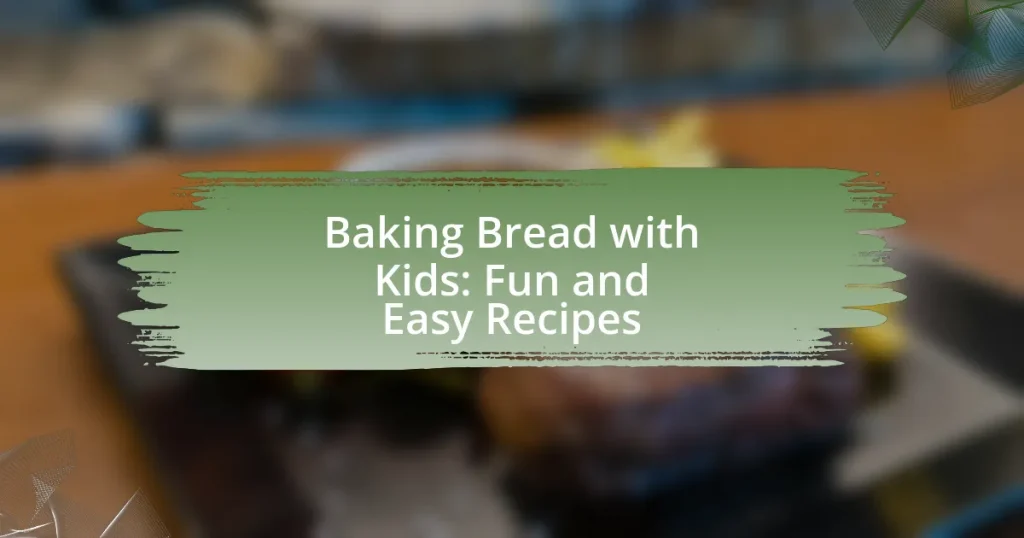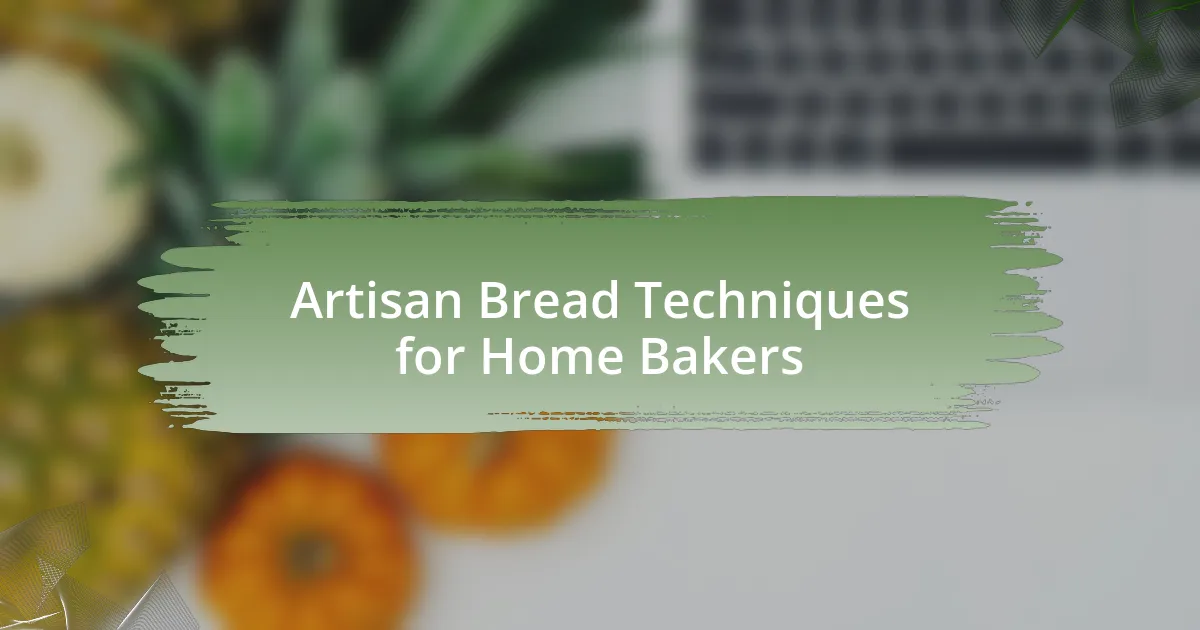Baking bread with kids is an engaging and educational activity that fosters creativity, fine motor skills, and basic math and science concepts. This article explores the benefits of involving children in the bread-making process, highlighting suitable recipes, essential ingredients, and necessary tools. It also addresses safety precautions, common challenges, and strategies to keep kids motivated and engaged throughout the baking experience. By providing easy-to-follow recipes and tips for personalizing bread, the article aims to enhance family bonding and create lasting memories through the joy of baking together.

What is Baking Bread with Kids?
Baking bread with kids is an engaging activity that involves children in the process of making bread, allowing them to learn about cooking and develop practical skills. This hands-on experience fosters creativity, enhances fine motor skills, and teaches basic math and science concepts through measuring ingredients and observing the dough rise. Research indicates that cooking with children can improve their confidence and willingness to try new foods, making it a valuable educational and bonding experience for families.
How can baking bread be a fun activity for children?
Baking bread can be a fun activity for children because it engages their senses and allows for hands-on learning. Children can mix ingredients, knead dough, and observe the transformation of simple components into a finished product, which fosters creativity and a sense of accomplishment. Additionally, baking bread provides an opportunity for children to learn about measurements, following instructions, and the science of yeast fermentation, making it both educational and enjoyable. Engaging in this activity together can also strengthen family bonds and create lasting memories.
What skills do kids develop while baking bread?
Kids develop various skills while baking bread, including fine motor skills, math skills, and teamwork. Fine motor skills are enhanced through activities like kneading dough and measuring ingredients, which require hand-eye coordination and dexterity. Math skills are developed as children measure ingredients, follow recipes, and understand concepts like fractions and volume. Teamwork is fostered when kids collaborate in the baking process, learning to communicate and share responsibilities. These skills contribute to their overall cognitive and social development, making baking a valuable educational activity.
Why is baking bread a great bonding experience for families?
Baking bread is a great bonding experience for families because it encourages teamwork and communication among family members. When families engage in the process of measuring ingredients, kneading dough, and waiting for the bread to rise, they share responsibilities that foster collaboration. This shared activity not only enhances relationships but also creates lasting memories, as families often reminisce about the fun and challenges faced during the baking process. Research indicates that cooking together can strengthen family bonds and improve communication skills, making baking bread an effective way to connect.
What types of bread are suitable for baking with kids?
Simple breads such as no-knead bread, soda bread, and flatbreads are suitable for baking with kids. These types of bread require minimal ingredients and straightforward techniques, making them accessible for young bakers. No-knead bread involves mixing flour, water, yeast, and salt, allowing the dough to rise without extensive handling, which is ideal for children. Soda bread uses baking soda as a leavening agent, requiring only mixing and shaping, while flatbreads can be rolled out and cooked quickly, providing an engaging hands-on experience. These methods promote learning and creativity in a fun baking environment.
What are some easy bread recipes for beginners?
Some easy bread recipes for beginners include no-knead bread, banana bread, and soda bread. No-knead bread requires minimal ingredients—flour, water, yeast, and salt—and involves mixing them and letting the dough rise for 12-18 hours before baking, making it simple and forgiving. Banana bread utilizes ripe bananas, flour, sugar, eggs, and baking soda, and can be mixed in one bowl, making it accessible for novice bakers. Soda bread, made with flour, baking soda, salt, and buttermilk, requires no yeast and can be prepared quickly, typically in under an hour. These recipes are ideal for beginners due to their straightforward methods and minimal equipment requirements.
How can we adapt recipes for different age groups?
To adapt recipes for different age groups, modify ingredients, preparation methods, and portion sizes according to the developmental needs and abilities of each group. For example, younger children may require simpler recipes with fewer steps and softer textures, while older children can handle more complex tasks and flavors. Research indicates that engaging children in age-appropriate cooking activities enhances their learning and interest in food (American Academy of Pediatrics, 2019). Therefore, tailoring recipes not only ensures safety but also promotes skill development and enjoyment in cooking.
What ingredients are essential for baking bread with kids?
The essential ingredients for baking bread with kids are flour, water, yeast, salt, and sugar. Flour serves as the primary structure for the bread, while water activates the yeast and hydrates the flour. Yeast is crucial for fermentation, allowing the dough to rise, and salt enhances flavor and controls yeast activity. Sugar provides food for the yeast, promoting fermentation and adding sweetness. These ingredients are fundamental in bread-making, as they work together to create the desired texture and taste.
What are the basic ingredients needed for bread making?
The basic ingredients needed for bread making are flour, water, yeast, and salt. Flour provides the structure and gluten necessary for the bread’s texture, while water hydrates the flour and activates the yeast. Yeast is a crucial ingredient that ferments the sugars in the flour, producing carbon dioxide that causes the dough to rise. Salt enhances flavor and controls yeast activity, ensuring proper fermentation. These four ingredients are fundamental to traditional bread recipes, forming the basis for various types of bread.
How can we choose kid-friendly ingredients?
To choose kid-friendly ingredients, prioritize options that are nutritious, appealing, and easy to handle. Ingredients such as whole grain flour, fruits, and vegetables provide essential nutrients while being visually attractive and flavorful, making them more appealing to children. Research indicates that involving kids in the selection of ingredients increases their willingness to try new foods, as noted in a study published in the Journal of Nutrition Education and Behavior by authors H. A. Contento et al. Therefore, selecting colorful, healthy ingredients not only enhances the nutritional value of baked goods but also engages children in the cooking process, fostering a positive attitude towards food.
How can we ensure safety while baking with kids?
To ensure safety while baking with kids, adults should supervise all activities closely and establish clear safety rules. This includes teaching children about the dangers of hot surfaces, sharp utensils, and proper hygiene practices. For instance, using oven mitts when handling hot trays and ensuring that children wash their hands before and after handling food are essential steps. According to the American Academy of Pediatrics, involving children in cooking can enhance their understanding of kitchen safety, provided they are guided appropriately.
What safety precautions should we take in the kitchen?
To ensure safety in the kitchen, it is essential to follow specific precautions such as keeping sharp objects out of reach, using oven mitts when handling hot items, and ensuring that surfaces are clean to prevent slips and falls. These measures are critical because kitchen injuries can occur frequently; for instance, the National Safety Council reports that over 400,000 injuries occur annually in the kitchen due to slips, cuts, and burns. By implementing these safety practices, the risk of accidents can be significantly reduced, creating a safer environment for baking with kids.
How can we teach kids about kitchen safety?
To teach kids about kitchen safety, start by explaining the importance of safety rules, such as washing hands before cooking, using oven mitts when handling hot items, and keeping sharp objects out of reach. Engaging children in discussions about potential hazards, like hot surfaces and slippery floors, reinforces their understanding. Research indicates that children who receive hands-on training in kitchen safety are more likely to remember and apply these practices, leading to a safer cooking environment.
What tools and equipment are needed for baking bread with kids?
To bake bread with kids, essential tools and equipment include mixing bowls, measuring cups and spoons, a whisk or wooden spoon, a baking sheet or loaf pan, and an oven. These items facilitate the mixing, measuring, and baking processes, making it easier for children to participate in each step. For example, mixing bowls allow for combining ingredients, while measuring cups ensure accurate proportions, which is crucial for successful bread-making. Additionally, a baking sheet or loaf pan is necessary for shaping the dough and placing it in the oven, where the bread will bake at the appropriate temperature.
What are the essential baking tools for children?
The essential baking tools for children include a mixing bowl, measuring cups, measuring spoons, a whisk, a rolling pin, cookie cutters, and an apron. These tools are designed to be safe and easy to use, allowing children to participate in baking activities effectively. For instance, mixing bowls come in various sizes, making it easier for kids to handle different quantities of ingredients. Measuring cups and spoons help children learn about portion sizes and accuracy in baking, which is crucial for successful recipes. A whisk is lightweight and simple to maneuver, while a rolling pin is essential for flattening dough. Cookie cutters provide a fun way for children to shape their baked goods, and an apron protects their clothing during the process. These tools not only facilitate the baking experience but also promote learning and creativity in the kitchen.
How can we make baking tools more accessible for kids?
To make baking tools more accessible for kids, manufacturers should design child-friendly utensils that are lightweight, ergonomically shaped, and made from safe materials. For instance, using silicone or plastic instead of metal can reduce the risk of injury, while smaller sizes can accommodate children’s hands better. Research indicates that tools specifically designed for children, such as mini whisks and measuring cups with easy-to-read markings, enhance their ability to participate in baking activities effectively. Additionally, educational programs can promote the use of these tools in schools and community centers, fostering a supportive environment for young bakers.

How can we make the baking process engaging for kids?
To make the baking process engaging for kids, involve them in hands-on activities such as measuring ingredients, mixing dough, and decorating baked goods. Research shows that children learn best through active participation, which enhances their understanding of concepts like measurements and transformations in cooking. Additionally, using colorful ingredients and fun shapes can capture their interest, making the experience enjoyable. Engaging kids in storytelling about the recipes or the origins of the ingredients can also spark their curiosity and creativity, further enriching the baking experience.
What fun activities can we incorporate while baking?
Incorporating fun activities while baking can enhance the experience for kids and make it more engaging. Activities such as decorating baked goods with colorful icing and sprinkles allow children to express their creativity. Additionally, measuring ingredients can be turned into a game by challenging kids to guess the amounts before measuring, which teaches them about fractions and volume. Another enjoyable activity is creating themed shapes with cookie cutters, which can be tied to holidays or favorite characters, making the baking process more relatable and exciting. These activities not only make baking enjoyable but also provide educational opportunities, reinforcing skills in math and creativity.
How can we turn baking into a learning experience?
Baking can be turned into a learning experience by incorporating educational elements such as math, science, and reading into the process. For instance, measuring ingredients teaches children about fractions and volume, while observing how ingredients change during baking introduces basic scientific concepts like chemical reactions and temperature effects. Additionally, following a recipe enhances reading comprehension and sequencing skills. Research shows that hands-on activities like baking can improve cognitive development and retention of knowledge, making it an effective educational tool.
What games can we play while waiting for the bread to rise?
While waiting for the bread to rise, you can play simple games like “I Spy,” “20 Questions,” or “Simon Says.” These games are engaging and require minimal setup, making them ideal for keeping kids entertained during the rising time. “I Spy” encourages observation skills, “20 Questions” promotes critical thinking, and “Simon Says” enhances listening and following directions. Each game can be played in a short time frame, aligning perfectly with the typical duration of bread rising, which is usually around 30 to 60 minutes.
How can we encourage creativity in kids during baking?
To encourage creativity in kids during baking, provide them with a variety of ingredients and tools to experiment with. Allowing children to choose their flavors, colors, and shapes fosters their imagination and personal expression. Research shows that hands-on activities, like baking, enhance cognitive development and problem-solving skills in children, making the experience both educational and enjoyable. By incorporating unique toppings, alternative flours, or themed decorations, kids can explore their creativity while learning about baking techniques and flavor combinations.
What are some ways to personalize bread recipes?
To personalize bread recipes, one can incorporate various ingredients and techniques that reflect individual tastes and preferences. For instance, adding herbs like rosemary or thyme can enhance flavor, while incorporating different types of flour, such as whole wheat or rye, can alter texture and nutritional value. Additionally, including mix-ins like nuts, seeds, or dried fruits allows for customization based on dietary needs or flavor preferences. Adjusting the sweetness by varying the amount of sugar or using honey can also tailor the recipe to suit personal tastes. These methods not only create unique bread but also engage children in the baking process, making it a fun and educational experience.
How can kids decorate their bread creations?
Kids can decorate their bread creations using various toppings and spreads. They can use ingredients like seeds, nuts, dried fruits, and colorful vegetables to create fun designs. For example, sesame seeds can be sprinkled on top for texture, while olives can be used to make eyes on a bread animal shape. Additionally, kids can use food coloring to dye dough or create patterns with icing made from powdered sugar and water. These methods not only enhance the visual appeal of the bread but also encourage creativity and experimentation in the kitchen.

What are some common challenges when baking bread with kids?
Common challenges when baking bread with kids include managing their attention spans, ensuring safety around hot surfaces and sharp tools, and dealing with messiness during the process. Kids often have shorter attention spans, which can lead to impatience and distractions, making it difficult to follow through with the recipe. Safety is a concern as children may not fully understand the dangers of hot ovens or sharp utensils, requiring constant supervision. Additionally, the process of mixing, kneading, and shaping dough can create a significant mess, which may be overwhelming for some caregivers to handle. These challenges can be mitigated with preparation and clear instructions, but they remain prevalent when involving children in baking activities.
What mistakes do kids often make while baking?
Kids often make several mistakes while baking, including mismeasuring ingredients, not following the recipe accurately, and neglecting to preheat the oven. Mismeasuring ingredients can lead to imbalanced flavors and textures, as precise measurements are crucial in baking. Not following the recipe can result in missing key steps or ingredients, which can affect the final product’s quality. Additionally, neglecting to preheat the oven can cause baked goods to rise improperly, leading to undesirable outcomes. These common errors highlight the importance of careful attention to detail in the baking process.
How can we troubleshoot common baking issues?
To troubleshoot common baking issues, identify the specific problem and adjust ingredients or techniques accordingly. For instance, if bread does not rise, check the yeast’s expiration date and ensure the water temperature is between 100°F and 110°F, as yeast is activated within this range. If the bread is too dense, consider increasing the kneading time or allowing for a longer rising period, as proper gluten development is crucial for lightness. Additionally, if baked goods are too dry, verify the accuracy of measurements and consider adding moisture through ingredients like eggs or milk. These adjustments are based on established baking principles that emphasize the importance of ingredient interaction and environmental conditions in achieving desired results.
What should we do if the bread doesn’t rise properly?
If the bread doesn’t rise properly, check the yeast for freshness and ensure it is activated correctly. Yeast is crucial for fermentation, and expired or improperly activated yeast can prevent the dough from rising. Additionally, verify that the dough is in a warm environment, as temperatures below 75°F can slow yeast activity. If the dough still fails to rise, consider kneading it longer to develop gluten, which helps trap gas produced by the yeast.
How can we keep kids motivated during the baking process?
To keep kids motivated during the baking process, engage them with hands-on activities and allow them to make choices. Involving children in selecting recipes or ingredients fosters a sense of ownership and excitement. Research indicates that children are more likely to stay engaged in tasks when they have autonomy, as highlighted in a study by Deci and Ryan (2000) on intrinsic motivation. Additionally, incorporating fun elements, such as decorating baked goods or using colorful ingredients, can enhance their interest and enjoyment in the activity.
What rewards can we offer for successful baking?
For successful baking, we can offer rewards such as certificates of achievement, small baking-related prizes, or a special treat like a favorite dessert. Certificates of achievement recognize the effort and skill demonstrated during the baking process, fostering a sense of accomplishment. Small prizes, such as cookie cutters or baking utensils, encourage continued interest in baking. Treats, like enjoying the baked goods together, create a rewarding experience that reinforces the joy of baking. These rewards not only celebrate success but also motivate further engagement in baking activities.
How can we celebrate the finished bread together?
To celebrate the finished bread together, gather everyone around the freshly baked loaf and share slices while discussing the baking process. Engaging in conversation about the ingredients and techniques used fosters a sense of accomplishment and teamwork. Additionally, incorporating a small tasting party with various spreads or toppings can enhance the experience, making it enjoyable and memorable for all participants. This approach not only highlights the effort put into baking but also strengthens family bonds through shared enjoyment of the final product.
What are some tips for successful bread baking with kids?
To successfully bake bread with kids, involve them in every step of the process, from measuring ingredients to kneading dough. Engaging children in hands-on activities enhances their learning and keeps them interested. Use simple recipes that require minimal ingredients and time, such as no-knead bread or quick bread, which can be completed in under two hours. Additionally, ensure safety by supervising them closely, especially when using kitchen tools like knives or ovens. Research shows that children who participate in cooking develop better math and science skills, as they measure ingredients and observe changes in the dough during baking.
How can we plan a baking session effectively?
To plan a baking session effectively, start by selecting a simple recipe that is suitable for kids, such as a basic bread recipe. This ensures that the process is manageable and enjoyable for young bakers. Next, gather all necessary ingredients and tools beforehand, including flour, yeast, water, and mixing bowls, to streamline the baking process and minimize distractions.
Additionally, create a timeline for the session, allocating specific time for preparation, baking, and cooling, which helps maintain focus and organization. Engaging kids in each step, from measuring ingredients to kneading dough, enhances their learning experience and keeps them interested.
Research indicates that hands-on activities like baking can improve children’s math and science skills, as they measure ingredients and observe chemical reactions during baking. By following these steps, you can ensure a successful and enjoyable baking session with kids.
What are the best practices for cleaning up after baking?
The best practices for cleaning up after baking include immediately clearing the workspace, washing utensils and bowls used, and wiping down surfaces. Clearing the workspace prevents clutter and allows for efficient cleaning. Washing utensils and bowls right after use minimizes the risk of dried-on food, making them easier to clean. Wiping down surfaces with a suitable cleaner removes flour, sugar, and other residues, ensuring a hygienic environment. Following these steps promotes a tidy kitchen and prepares the space for future baking activities.




